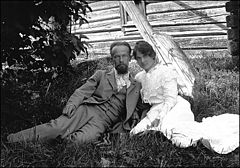- Otto Manninen
-
Otto Manninen 
Born 13 August 1872
Kangasniemi, Grand Duchy of FinlandDied 6 April 1950 (aged 77)
Helsinki, FinlandLanguage Finnish Alma mater Helsinki University Spouse(s) Anni Swan (1907–) Otto Manninen (13 August 1872, Kangasniemi, Southern Savonia – 6 April 1950, Helsinki) was a Finnish writer, poet, and a celebrated translator of world classics into Finnish language.[1] Along with Eino Leino in the early 20th century, he is considered as a pioneer of Finnish poetry. Manninen translated the works of Homer, Sophokles, Euripedes, Heine, Ibsen, Petőfi and Runeberg into Finnish language.
Contents
Life
Manninen was born in Kangasniemi in a farmer family. He was one of the ten children of Topias and Matilda Manninen. After passing the matriculation examination in 1892, he took admission in the University of Helsinki and received his Bachelor of Arts degree in 1897. From 1898-99 he was an assistant editor of the periodical Valvoja. His early translations of Heine were published in the student magazine of the University, Koitar in 1897. Parts of Heine's Saksanmaa (Deutschland. Ein Wintermärchen) were published later in the Valvoja in 1900 and the complete translation was published in 1904.
From 1907–1909 Manninen worked for the Finnish National Theatre. In 1913 he became a teacher of Finnish language at the University of Helsinki, where he remained till 1937. Manninen was a member of editorial staff of several non-fiction books, including Tietosanakirja (1909–21), and the chairperson of the National Council for Literature for nearly fifteen years. During the Civil War (1918), Manninen supported the White Guards and he himself was a member of the Civil Guards.
On 10 February 1907, Manninen married Anni Swan, a noted Finnish writer of fairy tales and the books for children. They had three sons, Antero (1907–2000), Sulevi (1909–36), and Mauno (1915–1969). From the 1910s, the Manninen family spent their summers on the island of Kotavuori in Puulavesi, where they built a house. In the serene environment of Kotavuori, Manninen spent most of his time in writing poems and completing his translations.
In 1939, he received Hungarian Pen Club medal. Manninen died in Helsinki on 6 April 1950 after a short period of illness. In 1954, his statue by the sculptor Wäinö Aaltonen was installed in Mikkeli.
Literary works
The literary career of Manninen started relatively late in 1905, when his first anthology of poems Säkeitä I was published. A number of poems in this collection were already appeared in other anthologies. In this work, Manninen used his huge vocabulary of old written language, to archaisms and his own neologisms, which went unnoticed. The reviews considered it difficult due to its compressed expression.
Manninen published his works at long intervals. In 1910, his second collection of poems, Säkeitä II was published. Again, it took another 15 years to finish his next work, Virrantyven (1925). Virrantyven mostly consists of the poems written on various anniversaries, translations, and patriotic poems written in the aftermath of the civil war of 1918.
Manninen's last collection of poems during his lifetime, Matkamies was published in 1938. It included several poems, lsuch as Nyt (now) and Kaukainen tie (distant road), which dealt with the loss of his son Sulevi. In these poems, Manninen described him as a guiding star, helping his father to accept his own fate. An anthology of his poems, Muistojen tie was published posthumously from the poet's literary estate in 1951.
Manninen translated a number of world classics into Finnish which include Sophokles’ Oedipus the King (1937), Euripides’ Medeia (1949), Homer's Iliad (1919) and Odyssey (1924) and Goethe's Faust (second part 1934, first part 1936) and Hermann and Dorothea (1929). In his translations, Manninen tried to be faithful to the original.
He translated a number of works of the national poet of Finland, Johan Ludvig Runeberg from Swedish language. He along with Juhani Aho, Paavo Cajader, Arvi Jännes, Eino Leino and Alpo Noponen translated Runeberg’s Fänrik Ståls sägner (Vänrikki Stoolin tarinat in Finnish) in 1909. He also translated Runebarg’s Hanna (1940), Kung Fjalar (1944) and Nadeschda (1948) into Finnish.
References
- ^ Raavila, Paavo. Finnish Literary Reader. London: RoutledgeCurzon. p. 153. ISBN 0700708448. http://books.google.co.in/books?id=b-1PG8_xOh4C&pg=PA153&dq=Otto+Manninen&hl=en&ei=O-1_TOr8HIOMvQODmJmEBA&sa=X&oi=book_result&ct=result&resnum=1&ved=0CCgQ6AEwAA#v=onepage&q=Otto%20Manninen&f=false.
External links
- Works by Otto Manninen at Project Gutenberg
- Works by or about Otto Manninen in libraries (WorldCat catalog)
Categories:- 1872 births
- 1950 deaths
- People from Kangasniemi
- Writers from Southern Savonia
- Finnish writers
- People of the Finnish Civil War (White side)
Wikimedia Foundation. 2010.
